
Postage Stamps of the United States - 1851
Politics
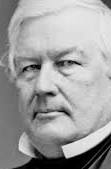
President
Millard Fillmore
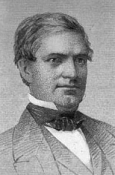
Postmaster General
Nathan K. Hall
Music
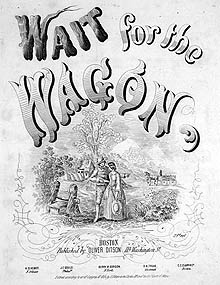
Click Control Above To Hear
1851 "Wait for the Wagon"
Postage Rates
The following rates applied as of July 1, 1851 - see 1847 for rates prior to that date.
Domestic Letter Rate Under 3000 mi. per ½ oz Prepaid: 3¢ · Not Prepaid: 5¢
Domestic Letter Rate Over 3000 mi. per ½ oz Prepaid: 6c Not Prepaid: 10
Foreign Letter Rate under 2500 mi. per ½ oz.: 10 except where otherwise adjusted by treaty
Foreign Letter Rate over 2500 mi. per ½ oz.: 20 except where otherwise adjusted by treaty
Rate for Drop Letters: 1 - prepayment not required - no weight restrictions
Stamps
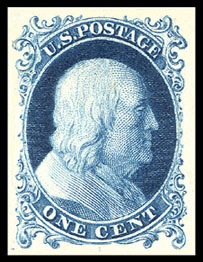
1¢ Franklin
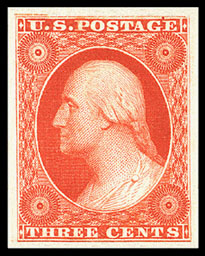
3¢ Washington
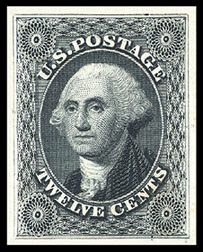
12¢ Washington
Designs of the 1851-1860 U.S. Issues Printed by Toppan, Carpenter, Casilear & Company
Note that only the 1¢, 3¢ and 12¢ stamps were issued in 1851 Designer: Edward Purcell
Engravers: The vignette work is generally attributed to Joseph Pease.
Geometric lathe designs on the 3 , 5 , 12 and 24 stamps are attributed to Cyrus Durand
The lettering is attributed to Henry Earle with probable help from Henry Saulnier and William Smillie.
The examples shown are proofs of the 1851-1860 design.
The following postage stamp design and varieties were first issued by the U.S. in 1851
Imperforate Printed in Sheets of 200 - Panes of 100
The design size of the one-cent stamp, 20 x 26 mm, is taller than the other stamps in this series. The 5¢ is a close second at 19.5 mm wide and 25.5 mm tall and was subject to some of the same modifications that allowed the design to fit in the allotted space, that is portions of the top and bottom of the designs were removed. On the one-cent stamp the alterations created the many type variations that resulted in so many Scott numbers. The five-cent stamp was altered by removing the projections in the lathe work at the top and bottom. The ten-cent stamp was modified in a very similar manner to the one-cent stamp, although it's design size, 19 x 24.25 mm, did allow it to fit in the allotted space. I am not certain why the ten-cent stamps were altered at top and bottom and found no mention of the reason in the literature. The entire list of design sizes may be found on the 1851 identifier page.
Only the one-cent, three-cent and twelve-cent stamps were issued in 1851. The one-cent stamp was required to pay the fee for drop letters and circulars under 500 miles. The three-cent stamp was the workhorse of the group paying the fee for pre-paid single letters. The five-cent stamp, not issued until 1856, paid the registration fee, although it is not certain the stamp was issued for this reason. The ten-cent stamp paid the foreign single letter rate under 2500 miles. The twelve-cent stamp paid twice the domestic rate over 3000 miles. The twenty-four cent stamp was for the single letter rate to Great Britain. The thirty-cent stamp paid the single letter rate to Germany and the ninety-cent stamp was issued as a catch-all for items requiring large amounts of postage. Of course, any of the stamps could be combined to make up the proper rate, leading to some interesting and very collectible uses. In some cases, higher value stamps were cut in half, often diagonally, to make up the lower rate. These are known as bisects and, if certified as genuine, very valuable to collectors.
The ten-cent stamp was first issued in 1855, the five-cent stamp in 1856 and the twenty-four, thirty- and ninety-cent stamps not until 1860.
The One-cent Stamp - Issued July 1, 1851 - EDUs of July 1, 1851 are considered First Days
1¢ Franklin Type I (Pos. 7R1E only) - EDU: July 5, 1851 - est. 35,000 issued
1¢ Franklin Type Ib (from Plate 1E only) - EDU: July 1, 1851 (FDC) - about 210,000 issued
1¢ Franklin Type II (from Plates 1E, 1L, 2, 3 and 4) - EDU (Plate 1E): July 1, 1851 (FDC)
EDU (Plate 2): Dec. 5, 1855 - EDU (Plate 3): May 6, 1856 - about 12.3 million issued
1¢ Blue Franklin Type III (from Plates 2 and 4 only) - EDU: Sep. 21, 1851 (off-cover)
- note that only one stamp from plate 2 was Type III, Pos. 99R2,the most desirable example of this type
1¢ Franklin Type IIIa (from Plates 1E, 2 and 4 only) - EDU (Plate 1E): July 3, 1851 - EDU (Plate 4): April 4, 1857 - (we could not find an EDU for Plate 2) - est. about 1 million issued
There are many, many collectible varieties of the one-cent stamp. This stamp is not only collected by type, but also by plate position and sometimes by relief (the characteristics of the die used to make the transfer to the plate). The authoritative books on the subject were written by Stanley Ashbrook and Mortimer Neinken.
Three-cent Stamp - Issued July 1, 1851
There were 9 plates used to print the 3c imperforate stamp, i.e. Plates 1 through 8, and an unmarked plate, plate 0. In addition, there were what are regarded as "early", "intermediate", and "late" plates of Plate 1 and "early" and "late" plates of Plate 2 and Plate 5.
3¢ Orange Brown Washington (known plates: 1E; 1i; 2E; 5E; and 0) - about 20 million issued
Plate 1E EDU: July 1, 1851 (FDC) - 43 documented covers as of 2005
Plate 1i (intermediate) EDU: July 12, 1851
Plate 2E EDU: July 23, 1851
Plate 5E EDU: July 19, 1851
Plate 0 EDU: September 6, 1851
3¢ Washington - Printed on both sides (only one example known)
3¢ Brownish Carmine Washington - about 340 million
Plate 1L EDU:Oct. 6, 1851
Plate 2L EDU: Jan. 7, 1852
Plate 3 EDU: Jan. 15, 1852
Plate 4 EDU: Mar. 28, 1855
Plate 5L EDU: Jul. 13, 1855
Plate 6 EDU: Feb. 18, 1856
Plate 7 EDU: Feb. 9, 1856
Plate 8 EDU: Apr. 14, 1856
3¢ Washington - Vertical half (must be on cover)
3¢ Washington - Diagonal half (must be on cover)
3¢ Washington - Double impression
There are many, many collectible varieties of this stamp. The Scott U.S. Specialized is an excellent starting point, particularly when trying to get a fix on the relative value of the varieties, but even then can only scratch the surface of all the varieties of re-cutting that define this stamp. The authoritative book on the subject was written by Carroll Chase and is highly recommended.
Twelve-cent Stamp - Issued July 1, 1851
12¢ Washington - EDU: Aug. 4, 1851 - about 2.5 million issued
12¢ Washington - Bisect (used to pay the 6¢ rate) Diagonal half (must be on cover)
12¢ Washington - Bisect (used to pay the 6¢ rate) Vertical half (must be on cover)
12¢ Washington - Printed on both sides
Varieties of the twelve-cent stamp include recuts, double- and triple-transfers, cracked plate and part-India paper. The authoritative book on the subject was written by Mortimer Neinken.
Note: The quantities issued of the 1¢ Franklins are gross estimates - for the most part, there were no records kept of quantities issued of these stamps other than by year. Depending on the source the quantity issued may vary wildly. In point of fact, the Post Office has always regarded these as a single issue, the distinction is made by philatelists. The quantity of the 12¢ stamp can be regarded as a little more accurate, since there were no major varieties of the twelve cent imperforate.





